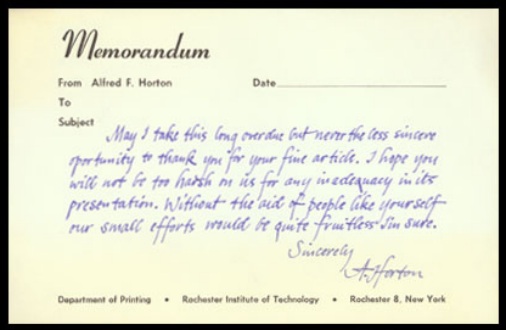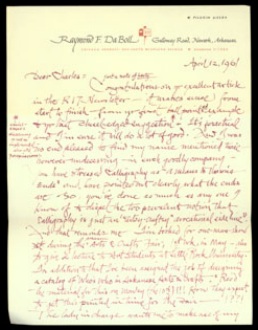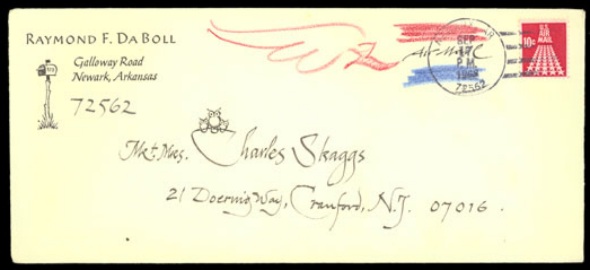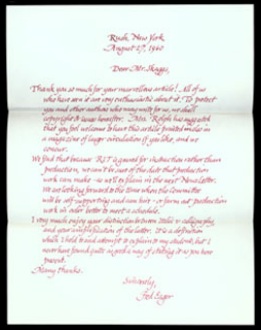
Rochester Institute of Technology (RIT) Newsletter
 |
“Calligraphy—A Means to Various Ends”Charles E. SkaggsRochester, New York: The Committee for Italic Handwriting Newsletter, spring & summer 1961 Charles Skaggs’ article appeared in this newsletter sponsored by Rochester Institute of Technology. He asserted that “improved everyday handwriting is one of the objectives of the study of calligraphy.” He also argued that calligraphy is often regarded as the “study of archaic forms” but that at least “token study of the history and style of those twenty six purely abstract characters we call our alphabet” is necessary to supplement the study of drawing, lettering, typography, and design in general. |
|
Skaggs also received some correspondence from those
involved in the production of the RIT Newsletter, thanking him for
his contribution: autograph note from Alfred A. Horton [1961] (below)
and autograph letter from Fred Eager, August 27, 1960 (right). Not
surprisingly, they are written in calligraphic hands.
|
|


|
Raymond F. DabollAutograph letter, signed. April 12, 1961This is one of several responses to Charles Skaggs’ article in the RIT Newsletter from friends and fellow calligraphers. DaBoll and Skaggs knew each other starting in the 1940s, and there are numerous letters from DaBoll in the Skaggs Collection. Here he congratulates Skaggs for the RIT article: “You’ve done as much as any one I know of to dispel the too prevalent notion that calligraphy is just an ‘artsty-craftsy’ avocational sideline.” Also shown here is an ornamented envelope from DaBoll to Skaggs from 1968. |
 |
Raymond F. Daboll, 1892-1981"Forsaking Rochester’s Athenaeum for Chicago’s Art Institute in 1914, Ray DaBoll was to become the Midwest’s laureate of letters. Early years of study with Fred Goudy and an apprenticeship with Oswald Cooper fostered a career that helped to pioneer the growth of calligraphy in America’s heartland. DaBoll’s natural gift for honest, unaffected letters reached its ultimate expression after exposure to the Newberry calligraphy study group. Thereafter, calligraphy was his all-consuming addiction, as he gave up his more commercial work in favor of books, tracts, insatiable study, and voluminous correspondence. His italic, lacking the polish or classicism of many Easterners, was written with directness and apparent independence from established models. And yet the result was as attractive and well suited to its subject as that written by any court scribe of the sixteenth century … DaBoll’s most characteristic specialty was a limitless variety of decorative initials. These creations, unlike any in copybook manuals, sprang straight from Mid-western grassroots—as did his familiar RFD monogram on a rural mailbox." --Charles Skaggs |

